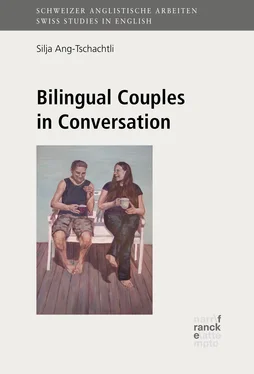Indeed, not all issues potentially faced by bilingual, bicultural couples can be traced back to the fact that they are from different cultures or speak different languages. There may also be communication differences based on their social background, age, family background, or gender. The role of gender appears to be particularly prominent, and it has often been suggested that men and women differ in their styles of talking as well as in the role and importance they attribute to talk in their relationship (e.g. Cameron 1997; Tannen 1986). Thus, communicative difficulties may arise because of a combination of language, culture, gender and other factors.
3.2.3.1 Socio-cultural practices, politeness and stereotypes stereotypescultural
Important aspects in which cross-cultural couples are likely to differ — at least to some extent — are their socio-cultural practices, rituals, and what they consider polite or appropriate behaviour. Even in Western countries, where customs and rituals may not be quite as important as in more traditional cultures, many habits are culturally rooted. Instances of such traditions may be the British pub culture, or the Swiss Sunday brunch, which is practiced by many families in Switzerland. Gonçalves (2013: ch 7) mentions a number of socio-cultural practices which the Swiss-Anglophone couples in her study consider to be Swiss, such as not wasting food, eating (high quality) bread, cooking proper meals, or using public transport. Moreover, there are a number of everyday rituals or social customs that are considered very important in Switzerland, such as waiting for everyone to sit down at the table and saying en Guete (‘enjoy your meal’) before starting to eat, or proposing a toast (repeatedly) before consuming alcohol. In contrast, Americans tend to be more accustomed to hugging each other, or celebrating Thanksgiving, while English people may find it important to queue properly. Not complying with such cultural practices may be considered rude. Thus, people from different cultures tend to have different ideas of what appropriate behaviour or polite manners are, and they may also have different ways of expressing politeness verbally.
Another area of conflict may be the stereotypical ideas partners have about each other’s culture, and expectations resulting therefrom (Rosenblatt 2009: 7). Stereotypes and expectations are likely to change if there is extended contact between cultures, but such contact “does not necessarily lead to a better understanding. On the contrary, it may reinforce mistaken judgments of the other’s intentions, and increase expectations that the other will behave a certain way” (Tannen 1981: 225). Of course, this can be true for monocultural couples as well, but such mistaken expectations may be more marked when there are larger differences between the partners, and when cultural stereotypes are involved. This becomes evident in Piller’s work on bilingual, cross-cultural couples, where national stereotypes often created conflicts between the partners (see section 3.3.2, “Bilingual couples”). She remarks that, in her research, “[t]he majority of instances of conflict between the partners occur when one partner ‘gets carried away’ with their chance to produce a list of stereotypes about their partner’s national identityidentitynational” (2002a: 210). This may be one of the reasons why numerous participants in her study claimed to be exceptions to their traditional national stereotypes (2002a: 211). Overall, however, it can be expected that preconceived notions of national characteristics are more complex and more differentiated among closely related cultures than among more distant ones, as the former tend to be in closer contact.
3.2.3.2 Religiousness religiousness , ideologies, values and gender
One aspect that might lead to conflicts in cross-cultural couples is that they often have different religions or denominations, or that they at least are religiously observant to differing degrees. The home countries of the subjects in this study are all traditionally Christian, and the majority of the population in all of the countries are affiliated with a Christian religion (England 59.3%, Australia 61.1%, Switzerland 69.9%, United States 78.5%, Northern Ireland 82.3).9 Between the countries, however, there are considerable differences with regard to the importance of religion and individual religiosity. In a survey, only 13% of the Swiss population stated that they would “definitely” consider themselves a religious person, and a mere 10% of the population claimed that they attended a church service or similar (almost) every week.10 In contrast, 53% of the American respondents stated that religion was “very important” to them, and another 27% rated it as “fairly important” in their lives (Gallup 2014). Moreover, 37% of all Americans reported that they attended church (almost) every week; however, it should be noted that it is possible that many people over-report their church attendance in the USA (Grossman 2014), and weekly attendance rates may actually be lower than 22% (Hadaway and Marler 2005: 307). Nonetheless, these high numbers indicate that church attendance is something to which many American people aspire. The reported level of religious observance is comparably high in Northern Ireland, where 30% of the population claim that they go to church weekly (Ashworth and Farthing 2007). In Australia and England, people appear to be observant to a similar degree as in Switzerland, with 14% of the English (British Social Attitudes 2014) and 8% of the Australians (McCrindle 2013) attending a church service every week.
Such differences with regard to religiousness or denomination between the partners can create tensions within their relationship. Moreover, religious views are often linked to other values and ideologies that may differ correspondingly. For instance, strongly religious cultures are inclined to be more conservative than less religious cultures, which seems to apply to the USA when compared to most of Western Europe. Such differences are also reflected in the stereotypesstereotypescultural that both cultures have of one another, as Europeans tend to see Americans as conservative, while the latter view the former as liberal. Gonçalves’ study on bilingual, bicultural couples supports this (see section 3.3.2, “Bilingual couples”), as some of her interviewees “discursively construct and position Americans as closed and strict compared to the Swiss as open and liberal” (2010: 245). A further characteristic that is linked to the American religious and historical background is their “effort optimism”, which refers to a “desire for assertiveness, action, and hard work” (Perel 2000: 187). While the Swiss are also known as hard workers, in my personal opinion, they tend to be less assertive than Americans.
Another challenge commonly faced by cross-cultural couples seems to be that one partner’s culture is more individualistic, while the other’s is more family-oriented (Rosenblatt 2009: 15). This appears to be an issue faced particularly by couples consisting of a Western and a non-Western partner, but European cultures also differ in their orientation towards family and individualism. Hofstede’s (1980) study of individualism versus collectivism in 40 cultures indicated that many English-speaking countries are very individualistic. Thus, the USA (91), Australia (90) and Great Britain (89) ranked the highest of all 40 countries in terms of individualism, while Switzerland (68) and Ireland (70) ranked lower — though still higher than the average (m = 51) of the countries (1980: 158). Fundamental differences in the partners’ family orientation sometimes emerge when they are faced with “life cycle events such as pregnancy, childbirth […] and deaths” (Rosenblatt 2009: 17). The same goes for ideas concerning child-rearing and parenting standards, between which there can be considerable differences based on the parents’ cultural background (Rosenblatt and Stewart 2004: 52).
Читать дальше












